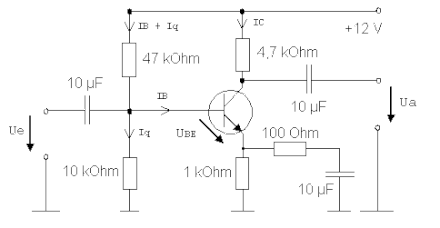Preamplifier
A preamplifier (called preamp - English : preamplifier , shortly preamp ; also precursor ) is an amplifier for instrumentation , sensors or audio and video technology , which has the task of adapting input signals of different electrical sources so that the subsequent stage (for example, Power amplifier) is working in its optimal working range. The adjustment can relate to the impedance , capacitance , level , frequency range , frequency response and waveform . Depending on the requirements, preamplifiers can be designed as separate devices or integrated in a higher-level device (e.g. in an integrated amplifier or a measuring device).

General
examples are
- Measurement preamplifier that processes various physical measured values for a digital display or an oscilloscope , for example .
- Audio preamplifier - it adapts the signals from source devices such as radios , cassette recorders , CD and record players to the power amplifier , the output stage . Audio preamplifiers are part of every integrated amplifier ("integrated"); They are also offered in separate housings and are then called preamplifiers, high-level preamplifiers (without phono amplifier ) or phono preamplifier (equalizes the phono signal and has a volume control).
- Preamplifier for instrumental amplification ( electric guitar , electric bass , electric piano , synthesizer and others). These are either part of an integrated unit (together with an output stage in an integrated amplifier) or individual components. The preamplifier (PreAmp) contains the sound-influencing control elements (standard elements: Gain, Bass, Mid, Treble, Presence) and is used to define the desired sound characteristics, which, unlike in the hi-fi area, also deliberately include overloads and deviations from linear transmission. Active electromagnetic pickups for electric guitars and basses have a preamplifier integrated into the pickup housing, which is usually supplied with electrical voltage via 9 V batteries. The instrument sound processed in this way is adapted for output in a loudspeaker system via a power amplifier , also known as an output stage . Preamplifiers are also used for audio recording without a downstream power amplifier.
Basically, preamplifiers, as far as they work analog, work in small-signal mode. This means that only a small section of the straight part of the characteristic curve of the active component used is controlled. This enables preamplifiers to generate extremely low harmonics .
Quality features of preamplifiers are usually (voltage) amplification, linearity, wide frequency range, low noise, insensitivity to external fields and mechanical vibrations ( microphones ) as well as high overload resistance . For audio applications, relative bandwidths (ratio of the upper to lower frequency limit) of three decades are the minimum criterion. In high-frequency technology , the relative bandwidths to be amplified are usually very much smaller. Instead, the focus is on low noise and high overload resistance (ratio between nominal and maximum input voltage).
Preamplifiers almost always have actuators that can change the gain, output voltage, spectral components, etc. in a defined manner. In the analog "world", these actuators are mostly potentiometers (adjustable resistors) or variable capacitors (for example in the VHF input section of a radio receiver). For example, multipliers are used in digital technology.
literature
- Helmut Röder, Heinz Ruckriegel, Heinz Häberle: Electronics 1st part, basics of electronics. 8th edition, Verlag Europa-Lehrmittel, Wuppertal, 1980, ISBN 3-8085-3178-9
- Siegfried Wirsum: Nf tricks for the audio freak. 1st edition, Franzis Verlag GmbH, Munich, 1990, ISBN 3-7723-3321-4
- Fritz Kühne: Low-frequency amplifier with tubes and transistors. 13th edition, Franzis Verlag, Munich, 1970
- Gustav Büscher, A. Wiegemann: Little ABC of electroacoustics. 6th edition, Franzis Verlag, Munich, 1972, ISBN 3-7723-0296-3